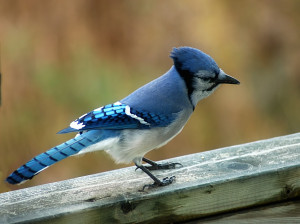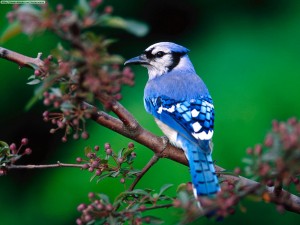This article demonstrates blue jay facts that are rarely known elsewhere. Blue jay is a small bird that belongs to the family of Cyanocitta cristata and is a resident of North America. These birds are also found in the southeastern Canada and Central United States. They breed in the deciduous forests. Except few, most of the species migrate from western part to the southeastern Canada.
Blue Jay Facts
These types of birds are primarily of blue color together with white underside feathers.
The clutch size comprises of 2 – 7 eggs.
Blue jays eggs are bluish white together with few brown markings.
Females and males are similar in their outlook. Sometimes, it is difficult to distinguish between the two.
The female usually hatches (keeping warm) eggs and the period lasts from 8 – 10 days.
The length of the blue jay measures around 22 – 30 cm (9 – 12 in).
These birds weigh around 70 – 100 grams (2.5 – 3.5 oz).
The blue jay wingspan is 34 – 43 cm (13 – 17 in).
The legs along with the eyes are black.
These birds have very strong bills that can crack even nuts, seeds, grains, and acorns.
These birds usually migrate in winter season.
The migration always takes place in daytime.
They migrate in the flocks of 10 – 250 birds.
These types of birds fly at a speed of 30 – 40 km/h (20 – 25 mph).
They sound an alarming voice when the predator arrives. Mostly, owls and eagles hunt them.
Blue jays are occasionally known to attack other birds that are smaller in size.
These species are considered to be intelligent and extraordinarily curious birds.
The length of the eggs measures about 2.5 – 3.3 cm (1 – 1.3 inches).
The blue jays eggs are 1.8 – 2.2 cm (0.7 – 0.9 inches) wide.
These beautiful birds produce several sounds that may vary from one species to another.
They are also known to copy human sounds.
The Blue Jay is the provincial bird of Prince Edward Island.

Where do Blue Jays Live?
- These birds are generally found in the South Florida, Central America, and Northeastern Texas.
- These species like to live in the open woodlands along with oaks and beeches.
- They usually avoid dense forests for their habitats.
- They are sociable birds and shows magnanimous attitudes toward humans. Blue jays are extensively found in the residential gardens and parks. However, they do not allow humans to come closer to their nests.
What do Blue Jays Eat?
- These birds primarily feed on soft fruits, small vertebrates, acorns, and arthropods.
- They also feed on grasshoppers, caterpillars, and beetles.
- They predominantly feed on plants, trees, weeds, fruits, berries, peanuts, small invertebrates, cache food, eggs, bread, and meat.
Blue Jay Reproduction Facts
- The mating season lasts from March to April.
- They build their nests on lush green trees that are at least 3 – 10 m high above the ground.
- The nests are built from materials like strips, small roots, twigs, plant material moss, paper and feathers.
- These birds are not very choosy in selecting trees for their habitats. They do sometimes compromise over the habitat.
- Males and females put their efforts together to build their nests.
- The females lay 4 – 5 eggs in a breeding season.
- The incubation (keeping warm) period lasts from 16 – 18 days.
- The chicks fledge out after 19 – 21 days.

Blue Jays Subspecies
Even though variety of subspecies has been found but the naturalists have confirmed only four of them that are:
- Cyanocitta cristata bromia – Northern Blue Jay Bird
- Cyanocitta cristata cristata – Coastal Blue Jay Bird
- Cyanocitta cristata cyanotephra – Interior Blue Jay Bird
- Cyanocitta cristata semplei – Florida Blue Jay Bird

Leave a Reply